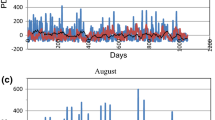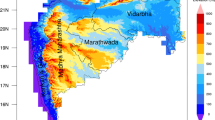Abstract
Upper Ganga (UG) and Sharda are two river basins in Uttarakhand, India that are situated in the western Himalayan region. Previous studies revealed that these basins are prone to high seasonal rainfall (more than 100 cm) and substantial interannual variations during the southwest monsoon season. However, synoptic situations causing heavy rainfall events in the basins are not properly understood. The present study attempts to understand the synoptic situations causing heavy rainfall events in the basins using synoptic analogue and rainfall data from India Meteorological Department, followed by a diagnostic assessment using ERA5 reanalysis data. The synoptic systems associated with heavy rainfall events in the basins are found to be different. Heavy rainfall events in UG are triggered by the movement of mid-latitude systems (trough in westerlies) towards north India which provide convergence at middle and upper tropospheric levels. These systems strengthen when they are supported by the northward progression of the monsoon trough (especially the western end of the monsoon trough) and embedded cyclonic circulations. We found that heavy rainfall events in UG are associated with the development of a cyclonic circulation extending up to the mid-troposphere/low-pressure system in the northwest Bay of Bengal. The mid-tropospheric divergence over this cyclonic circulation system feeds moisture to the convergence due to the southward extended trough in the mid-latitude westerlies and caters to the formation of heavy rainfall events in the basin. Heavy rainfall events in Sharda are associated with the movement of low-pressure systems from the Bay of Bengal towards the region, which provides anomalous convergence in the lower levels. It is supported by a trough in the mid-latitude westerlies in the mid and upper tropospheric levels, which increases the convergence at lower and mid-tropospheric levels and leads to heavy rainfall events in the basin. This study reveals the tropical-midlatitude interaction and its role in the heavy rainfall events over the western Himalayan region.









Similar content being viewed by others
Data availability
The gridded rainfall data used to produce Fig. 3 is from IMD (https://www.imdpune.gov.in/cmpg/Griddata/Rainfall_25_NetCDF.html). The fifth-generation ECMWF atmospheric reanalysis (ERA5) datasets were obtained from https://www.ecmwf.int/en/forecasts/datasets/reanalysis-datasets/era5. Station-wise rainfall data over Upper Ganga and Sharda basins and daily weather inferences are available on request from India Meteorological Department.
References
Ali M, Singh UP, Joardar D (2011) QPF model for lower Yamuna catchment, synoptic analogue method. Mausam 62(1):27–40
Arnell NW (2003) Effects of IPCC SRES emissions scenarios on river runoff: a global perspective. Hydrol Earth Syst Sci 7(5):619–641. https://doi.org/10.5194/hess-7-619-2003
Arora M, Kumar R, Singh RD, Malhotra J, Kumar N (2016) Analysis of unusual meteorological conditions that led to recent floods in Bhagirathi Basin (Uttarakh and Himalayas). Hydrol Sci J 61(7):1238–1243
Ben Daoud A, Sauquet E, Bontron G, Obled C, Lang M (2016) Daily quantitative precipitation forecasts based on the analogue method: improvements and application to a French large river basin. Atmos Res 169:147–159
Bhambri R, Mehta M, Dobhal DP, Gupta AK, Pratap B, Kesarwani K, Verma A (2016) Devastation in the Kedarnath (Mandakini) valley, Garhwal Himalaya, during 16–17 June 2013: a remote sensing and ground-based assessment. Nat Hazards 80(3):1801–1822
Dee DP et al (2011) The ERA–Interim reanalysis: configuration and performance of the data assimilation system. Q J R Meteorol Soc 137:553–597
Desaint B, Nogues P, Perret C, Garçon R (2008) Operational hydro-meteorological forecasting: the experience of Electricite de France. La Houille Blanche 95(5):39–46. https://doi.org/10.1051/lhb/2009054
Dobhal DP, Gupta AK, Mehta M, Khandelwal DD (2013) Kedarnath disaster: facts and plausible causes. Curr Sci 105(2):171–174
Dube A et al (2014) Forecasting the heavy rainfall during Himalayan flooding—June 2013. Weather Climate Extremes 4:22–34
Gadgil S, Joseph PV (2003) On breaks of the Indian monsoon. J Earth Syst Sci 112:529–558. https://doi.org/10.1007/BF02709778
Hamill TM, Scheuerer M (2015) Bates GT (2015) analog probabilistic precipitation forecasts using gefs reforecasts and climatology-calibrated precipitation analyses. Mon Weather Rev 143:3300–3309. https://doi.org/10.1175/MWRD-15-0004.1
Hamill T, Whitaker J (2006) Probabilistic quantitative precipitation forecasts based on reforecast analogs: theory and application. Mon Weather Rev 134:3209–3229. https://doi.org/10.1175/mwr3237.1
Hersbach H, Bell B, Berrisford P et al (2020) The ERA5 global reanalysis. Q J R Meteorol Soc 146:1999–2049. https://doi.org/10.1002/qj.3803
Horton P, Jaboyedoff M, Metzger R, Obled C, Marty R (2012) Spatial relationship between the atmospheric circulation and the precipitation measured in the western Swiss Alps by means of the analogue method. Nat Hazards Earth Syst Sci 12:777–784. https://doi.org/10.5194/nhess-12-777-2012
Horton P, Obled C, Jaboyedoff M (2017) The analogue method for precipitation prediction: finding better analogue situations at a sub-daily time step. Hydrol Earth Syst Sci 21:3307–3323. https://doi.org/10.5194/hess-21-3307-2017
Houze RA Jr et al (2017) Multiscale aspects of the storm producing the June 2013 flooding in Uttarakhand, India. Mon Wea Rev 145:4447–4466
Immerzeel WW, van Beek LPH, Bierkens MFP (2010) Climate change will affect the Asian water towers. Science 328:1382–1385
Krishnamurti TN, Kumar V, Simon A, Thomas A, Bhardwaj A, Das S, Roy SS, Roy Bhowmik RK (2017) March of buoyancy elements during extreme rainfall over India. Clim Dyn 48:1931–1951. https://doi.org/10.1007/s00382-016-3183-7
Lorenz E (1969) Atmospheric predictability as revealed by naturally occurring analogues. J Atmos Sci 26:636–646. https://doi.org/10.1175/1520-0469(1969)26%3c636:APARBN%3e2.0.CO;2
Marty R, Zin I, Obled C, Bontron G, Djerboua A (2012) Toward real-time daily PQPF by an analog sorting approach: application to flash-flood catchments. J Appl Meteorol Clim 51:505–520. https://doi.org/10.1175/JAMC-D-11-011.1
Messerli B, Viviroli D, Weingartner R (2004) Mountains of the world: vulnerable water towers for the 21st century. Ambio 13:29–34
Mishra PK, Thayyen RJ, Singh H, Das S, Nema MK, Kumar P (2022) Assessment of cloudbursts, extreme rainfall and vulnerable regions in the Upper Ganga basin, Uttarakhand, India. Int J Disast Risk Reduct 69:102744
Mohapatra PK, Singh RD (2003) Flood Management in India. Nat Hazards 28:131–143
Nijssen B, Lettenmaier DP, Liang X, Wetzel SW, Wood EF (1997) Streamflow simulation for continental scale river basins. Water Resour Res 33(4):711–724. https://doi.org/10.1029/96WR03517
Obled C, Bontron G (2005) A probabilistic adaptation of meteorological model outputs to hydrological forecasting. La Houille Blanche 1:23–28. https://doi.org/10.1051/lhb:200501002
Pai DS, Latha S, Rajeevan M, Sreejith OP, Satbhai NS, Mukhopadhyay B (2014) Development of a new high spatial resolution (0.25° × 0.25°) long period (1901–2010) daily gridded rainfall data set over India and its comparison with existing data sets over the region. Mausam 65(1):1–18
Priya P, Krishnan R, Mujumdar M, Houze RA Jr (2016) Changing monsoon and midlatitude circulation interactions over the Western Himalayas and possible links to occurrences of extreme precipitation. Clim Dyn 49:2351–2364. https://doi.org/10.1007/s00382-016-3458-z
Rajeevan M, Gadgil S, Bhate J (2010) Active and break spells of the Indian summer monsoon. J Earth Syst Sci 119:229–247. https://doi.org/10.1007/s12040-010-0019-4
Ram LC, Kaur S (2004) Quantitative precipitation forecast for Upper Yamuna Catchment by synoptic analogue method. Mausam 55(3):508–511
Ram M, Lal M (2011) Semi-quantitative precipitation forecasts for river Sharda catchment by synoptic analogue method. Mausam 62(2):256–260. https://doi.org/10.54302/mausam.v62i2.301
Rao YP (1976) Southwest Monsoon. Meteor Monogr Synoptic Meteor, No. 1/1976 376 India Meteorological Department
Ray K, Sahu ML (1998) A Synoptic analogue model for QPF of river Sabarmati basin. Mausam 49(4):499–502
Ray K, Joshi BN, Vasoya YM, Chicholikar JR (2014) Quantitative precipitation forecast for mahi basin based on synoptic analogue method. Mausam 65(1):118–123
Raynaud D, Hingray B, Zin I, Anquetin S, Debionne S, Vautard R (2016) Atmospheric analogues for physically consistent scenarios of surface weather in Europe and Maghreb. Int J Climatol 37:2160–2176. https://doi.org/10.1002/joc.4844
Sandeep S, Ajayamohan RS (2015) Poleward shift in Indian summer monsoon low level jetstream under global warming. Clim Dyn 45:337–351
Sandeep S, Ajayamohan R, Boos WR, Sabin TP, Praveen V (2018) Decline and poleward shift in Indian summer monsoon synoptic activity in a warming climate. Proc Nat Acad Sci 115(11):2681–2686. https://doi.org/10.1073/pnas.1709031115.
Sen D (2010) Flood hazards in India and management strategies. In: Jha MK (ed) Natural and anthropogenic Disasters: vulnerability, preparedness, and mitigation. Springer, Dordrecht, p 615
Sudeepkumar BL, Babu CA, Varikoden H (2018) Future projections of active-break spells of Indian summer monsoon in a climate change perspective. Glob Planet Chang 161:222–230
Teegavarapu RS (2012) Floods in a changing climate: Extreme precipitation. Cambridge University Press, International Hydrology Series, p 269
Vellore RK, Krishnan R, Pendharkar J, Choudhary AD, Sabin TP (2014) On the anomalous precipitation enhancement over the Himalayan foothills during monsoon breaks. Clim Dyn 43:2009–2031. https://doi.org/10.1007/s00382-013-2024-1
Vellore RK et al (2015) Monsoon-extratropical circulation interactions in Himalayan extreme rainfall. Clim Dyn 46:3517–3546. https://doi.org/10.1007/s00382-015-2784-x
Acknowledgements
The first and fourth authors are thankful to Dr. M. Mohapatra, DGM, India Meteorological Department and Mr. J. P. Gupta, Former Head, MC Lucknow for the facility and support. The first author is thankful to Mr. K.S. Hosalikar, Head, CRS Pune and Mr. A.D Tathe, CRS Pune. The third author acknowledges Council of Scientific and Industrial Research (CSIR) for providing fellowship grants (CSIR Award No: 09/625(0027)/2017-EMR-I).
Author information
Authors and Affiliations
Corresponding author
Additional information
Responsible Editor: Clemens Simmer, Ph.D.
Publisher's Note
Springer Nature remains neutral with regard to jurisdictional claims in published maps and institutional affiliations.
Supplementary Information
Rights and permissions
Springer Nature or its licensor (e.g. a society or other partner) holds exclusive rights to this article under a publishing agreement with the author(s) or other rightsholder(s); author self-archiving of the accepted manuscript version of this article is solely governed by the terms of such publishing agreement and applicable law.
About this article
Cite this article
Sudeepkumar, B.L., Jayasankar, C.B., Mudra, B.L. et al. A diagnostic study of heavy rainfall events in upper Ganga and Sharda river basins, India. Meteorol Atmos Phys 135, 20 (2023). https://doi.org/10.1007/s00703-023-00954-5
Received:
Accepted:
Published:
DOI: https://doi.org/10.1007/s00703-023-00954-5




